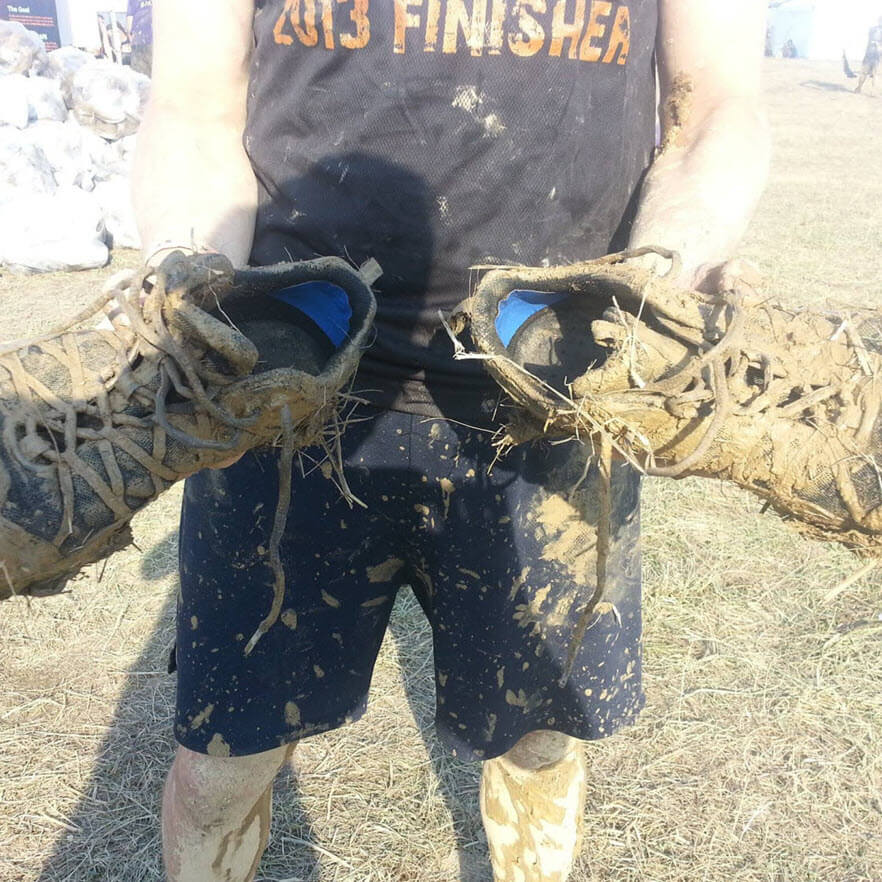ENGO Blister Patches prevent foot blisters in the best way possible, in my opinion. They're extremely durable, don't adversely effect the fit of your shoe, and maintain "good friction" so your foot still has traction in your shoe. While there's no single product, technique or strategy that is best for every blister at every anatomical location in every situation, ENGO Patches come the closest to being just that.
In this article, you will learn:
- How I discovered this product
- ENGO's mechanism of action
- It's pros
- And it's cons
- Where to buy
How I Discovered ENGO Blister Patches
I get foot blisters very easily. I can take all the stock-standard measures (perfectly fitting shoes, good lacing technique, moisture-wicking socks, wear my orthotics, and have me feet taped) and still get blisters. My fastest time-to-blister on my morning walk stands at 8 minutes!
So, as you can imagine, I’ve hunted high and low for something that works for my blister-prone feet. In 2009, after venting my frustration on a podiatry forum, I was contacted by Jason from Tamarack Habilitation Technologies Inc in Minnesota, USA. Tamarack HTI are in the business of, among other things, preventing shear-related skin damage. Basically, preventing blisters and skin tears at amputation sites where prostheses are used, and for people who are chairbound or bedridden.
It wasn't long after that I took delivery of a few packs of ENGO Blister Patches. I attached a couple of patches to the inside of my shoes and went for a walk. My heels were still recovering from previous blisters, so I wasn't expecting much. To my surprise, I felt no pain whatsoever through the whole 30 minute walk. I'm not a dramatic kind of person, but I remember thinking to myself it was as if angels were singing and a divine light was emanating from the back of my shoes!
Now I take it for granted that I don't get blisters. And that's the way it should be - for everyone. No matter what your activity, how sweaty your feet are, how hot it is where you live, or how blister-prone you are. That's why I've researched and written so extensively about blisters. ENGO Blister Patches aren't my only focus. But they're something I couldn't do without personally, or professionally in my clinic and at the 6-day ultramarathons I provide foot care at.
If you get blisters easily and nothing seems to help, read on.
Mechanism of Action
ENGO Blister Patches work by doing one thing only - but they do it well. That is, they reduce the coefficient of friction (COF).
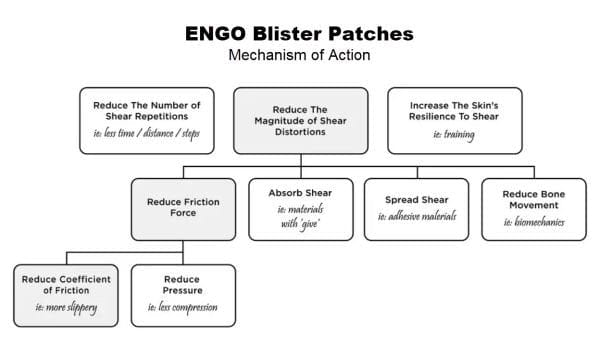
This is how ENGO Patches work
ENGO Patches reduce friction by reducing the coefficient of friction. Not by a little, by a lot! And they do this even moist conditions, like it invariably is inside your shoe. Take a look at these bar graphs – ENGO is the smallest bar in both. And it doesn’t matter whether it’s wet or dry. In essence, they take moisture out of the equation.
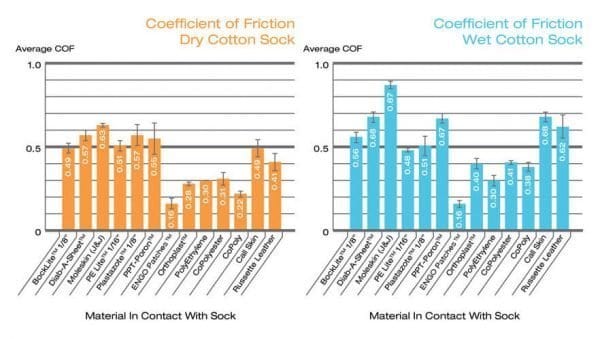
Coefficient of friction data of various in-shoe materials. ENGO reduces COF the most, in dry and wet conditions.
This exceptionally low COF is all thanks to the blue surface of the ENGO Patch. It is a material called Polytetrafluoroethylene (PTFE). PTFE was discovered accidentally by DuPont in 1938 as a non-stick and low friction material. Since then, it lead to the production of what we know as Teflon. You can read more about the remarkable material PTFE here and here.
ENGO Blister Patches Pros
Pro 1: Your Shoe Still Fits Perfectly
ENGO Blister Patches are very thin – only 0.38mm. There’s a significant advantage to this, and that is, they won’t change the way your shoe fits. This is important, especially in endurance activities where your feet swell. It’s also important if your shoes are tight already in certain areas – like if you’ve got a bunion. You simply can’t afford to add more bulk into your shoe in this area without making things worse. Blister pads, cushions and protectors all take up room in your shoe and can change shoe-fit.
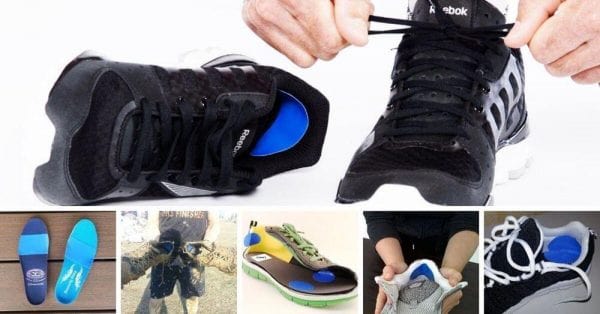
ENGO Blister Patches are extremely thin and don't change the fit of your shoe in any way.
Pro 2: They Last a LONG Time!
When you apply an ENGO Blister Patch to your shoe or insole, with just a tiny bit of care, it will stay there indefinitely. The adhesive is strong and the patches are extremely durable. You can expect a single ENGO Patch to last day after day, week after week, month after month – for a good 300 miles (~500kms). You’ll know it’s time to replace them if the blue surface wears through to white.
This has become the gold standard for longevity in blister prevention. And it has taken blister management for the following scenarios to a whole new level:
- Runners and hikers who cover long distances, day in, day out.
- Race situations where you don’t have time to stop to reapply your blister strategy, like lubricants or powders.
- People who are blister prone and just want to be able to put any shoe on… and go!
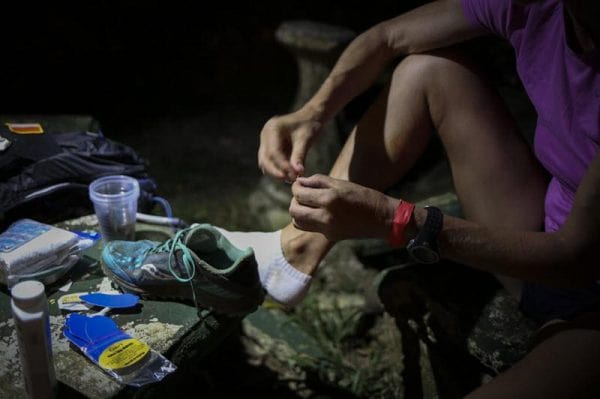
ENGO Blister Patches used by a runner at the Coastal Challenge Costa Rica 2015 ©iancorless.com – all rights reserved
Pro 3: They Allow Your Sock To Protect Your Skin
I think we take it for granted that our socks protect our feet. For the most part, high friction levels keep them stuck together. However, if the two rub against one another in a high friction situation, this is abrasive.
By reducing the COF between the shoe and sock, it means we're making things slippery between the shoe and sock at this specific patch location. In this way, the sock can remain in stationary contact with the skin instead of rubbing against it. This is the perfect case scenario for blister prevention.
Watch the video below the see how ENGO’s low friction work in this way.
Pro 4: They Maintain Good Friction
Now this is going to sound like I’m contradicting myself, so bear with me…
Friction is not bad. In fact, friction is necessary. We need friction for traction. Without traction (like when you put Vaseline all over your foot) it’s too slippery and your foot slides around too much in your shoe. This makes walking and running harder and less efficient. The detrimental effects on the efficiency of your gait, like propulsion (push-off), braking (slowing down), changing direction and on your balance, also make injuries more likely.
When you use ENGO Blister Patches, you put them just where you need them – only at those blister-prone areas. In this way, you’re relieving ‘bad’ friction to avoid blisters whilst maintaining ‘good’ friction elsewhere esle. This is the best way to manage friction. We call it targeted friction management.
Pro 5: Different Shapes & Sizes
Some blisters are small, like a blister on the outside of your pinky toe. You’d use a Small Oval Patch for this. Others can be huge, like blisters across the whole ball of your foot. You’d use the Rectangle Patch for this. That’s why ENGO Blister Patches come in 4 shapes and sizes. What's more, you can cut the patches with scissors to any size or shape you like. Read this useful resource to learn more about how to choose the right ENGO Patch and tips on how to apply it to your footwear so that you’re getting the most out of it.
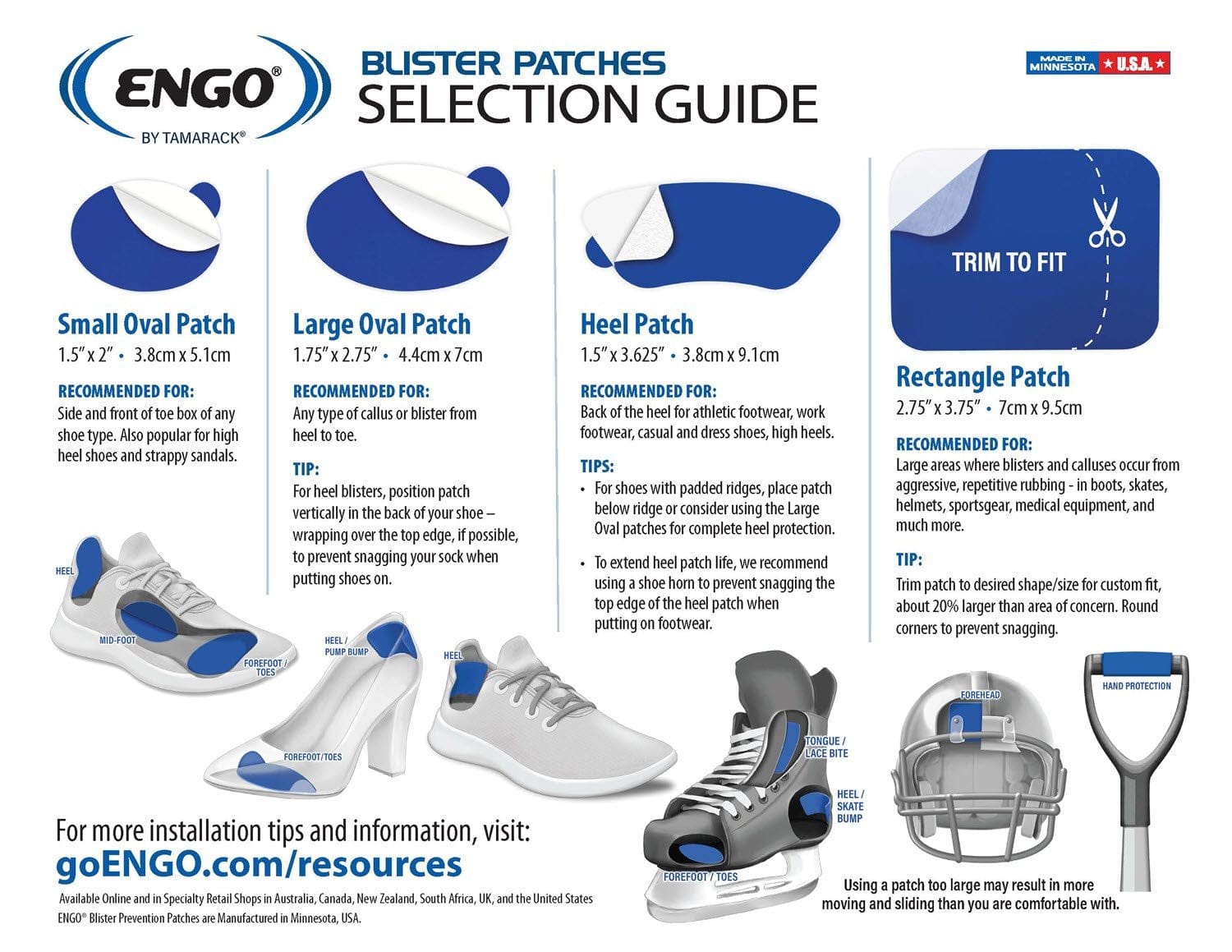
ENGO Patches Selection Guide
Pro 6: ENGO Patches Are Massive Time-Savers!
If you’re a runner and you run most days, or you're on a multiday hike, you’ll recognise the wasted time spent taping your feet. Or the mess of applying powder or lube to your feet each day, and sometimes a few times per day. Or if you’re blister prone (like me) and you have to apply your preferred blister strategy each morning just to get through the day, you’ll recognise what a drag this is – day in, day out!
ENGO Blister Patches change that. Once in place, you’re protected day after day, week after week, month after month. It saves time, it saves money, and there's no mess! But best of all, there's no better way to reduce the coefficient of friction than with an ENGO Patch. Take a look at the ENGO Blister Patch Placement Masterclass below to help you get started with ENGO Patches.
ENGO Blister Patch Placement Masterclass from Rebecca Rushton
ENGO Blister Patches Cons
Con 1: Waterlogging Situations
The biggest drawback of ENGO Blister Patches occurs when your shoes get waterlogged. If you need to cross creeks and rivers, if you're frequently running through puddles and wet grass, if you like to put your shoes in the washing machine - the patches will likely loosen.
Con 2: Shoe Must Be Clean and Dry
Similarly, the shoe needs to be absolutely clean and dry for them to stick. This can be a problem if you're a few hours in to your hike, your feet have been sweating profusley because it's a hot day, and you can feel a hotspot. Your Engo Patch is probably not going to stick as well as it could, because the shoe lining is damp. Even worse is if you've been using lubricants or powders which are now ingrained into your shoe lining. Nothing adhesive is going to stick in these conditions.
Con 3: Coming Loose
As your foot enters your shoe, if the sock catches the top of the patch, it can drag it down. This part of the patch will not stick back down. This is a problem almost exclusively for patches at the back of the heel. To counter this, always have your finger tips (or a shoe-horn) covering the top of the patch to guide your heel over that top edge. That way you'll increase the patch's longevity.
Con 4: Can Be Difficult To Place
Another limitation of ENGO Patches is when you need to get your patches up near your toes. Access can be tricky the further you get into the shoe. To counter this, remove your laces entirely to give yourself the best possible access.
Con 5: Won't Fix ALL Foot Problems
This isn't really a con. But it's easy to place unrealistic expectations on a product if you don't undertsand how it works. ENGO Patches do one thing and one thing only - they reduce friction force by reducing the coefficient of friction (see the chart at the top of this page). So if you have a problem that isn't caused by a high coefficient of friction, these patches won't help. A few common ailments people "hope" ENGO will fix include corns (mostly a pressure problem), pain under a prominent metatarsal head (mostly a pressure/functional problem) and nerve pain (mostly a foot function or medical problem).
Where To Buy ENGO Blister Patches
You can grab your ENGO Patches from our online store. We ship daily, worldwide, from USA and Australia.
Learn More About ENGO Blister Patches
Not sure how to apply ENGO Blister Patches?
Applying a blister prevention to your shoe rather than your skin is a bit out of the ordinary. Find out how to install the patches to ensure you’re making the most of each patch. Read more here or watch these videos.
Frequently Asked Questions
What if my shoes get wet? How do I know when they’re worn out? FAQs answered here. Plus video tutorials. Head to the ENGO FAQ page.
